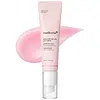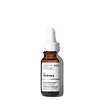What's inside
What's inside
 Key Ingredients
Key Ingredients

 Benefits
Benefits

 Concerns
Concerns

 Ingredients Side-by-side
Ingredients Side-by-side

Water
Skin ConditioningGlycerin
HumectantDipropylene Glycol
HumectantNiacinamide
SmoothingCaprylic/Capric Triglyceride
MaskingPentaerythrityl Tetraethylhexanoate
EmollientCetearyl Alcohol
EmollientGlycereth-26
HumectantButylene Glycol Dicaprylate/Dicaprate
EmollientBis-Behenyl/Isostearyl/Phytosteryl Dimer Dilinoleyl Dimer Dilinoleate
EmollientCetearyl Olivate
Sorbitan Olivate
EmulsifyingPropylene Glycol Dibenzoate
Skin ConditioningPullulan
1,2-Hexanediol
Skin ConditioningGlyceryl Stearate
EmollientVinyldimethicone
Hydroxyacetophenone
AntioxidantHydroxyethyl Acrylate/Sodium Acryloyldimethyl Taurate Copolymer
Emulsion StabilisingHydrogenated Lecithin
EmulsifyingSodium Acrylate/Sodium Acryloyldimethyl Taurate Copolymer
Emulsion StabilisingSodium Dna
Skin ConditioningPolyisobutene
Butylene Glycol
HumectantEthylhexylglycerin
Skin ConditioningPropanediol
SolventMelia Azadirachta Leaf Extract
Skin ConditioningAdenosine
Skin ConditioningMelia Azadirachta Flower Extract
Skin ConditioningCurcuma Longa Root Extract
MaskingSorbitan Isostearate
EmulsifyingSorbitan Oleate
EmulsifyingCaprylyl/Capryl Glucoside
CleansingFragaria Chiloensis Fruit Extract
Skin ConditioningHedera Helix Leaf/Stem Extract
AntimicrobialCyanocobalamin
Skin ConditioningCitrus Nobilis Peel Extract
MaskingRetinol
Skin ConditioningOcimum Sanctum Leaf Extract
Skin ConditioningLespedeza Capitata Leaf/Stem Extract
Skin ConditioningCorallina Officinalis Extract
Skin ConditioningSodium Hyaluronate
HumectantCaffeine
Skin ConditioningCoffea Arabica Seed Extract
MaskingHydrolyzed Extensin
Skin ConditioningHydrolyzed Hyaluronic Acid
HumectantCopper Tripeptide-1
Skin ConditioningSodium Acetylated Hyaluronate
HumectantAcetyl Hexapeptide-8
HumectantPalmitoyl Pentapeptide-4
Skin ConditioningPalmitoyl Tetrapeptide-7
Skin ConditioningPalmitoyl Tripeptide-1
Skin ConditioningWater, Glycerin, Dipropylene Glycol, Niacinamide, Caprylic/Capric Triglyceride, Pentaerythrityl Tetraethylhexanoate, Cetearyl Alcohol, Glycereth-26, Butylene Glycol Dicaprylate/Dicaprate, Bis-Behenyl/Isostearyl/Phytosteryl Dimer Dilinoleyl Dimer Dilinoleate, Cetearyl Olivate, Sorbitan Olivate, Propylene Glycol Dibenzoate, Pullulan, 1,2-Hexanediol, Glyceryl Stearate, Vinyldimethicone, Hydroxyacetophenone, Hydroxyethyl Acrylate/Sodium Acryloyldimethyl Taurate Copolymer, Hydrogenated Lecithin, Sodium Acrylate/Sodium Acryloyldimethyl Taurate Copolymer, Sodium Dna, Polyisobutene, Butylene Glycol, Ethylhexylglycerin, Propanediol, Melia Azadirachta Leaf Extract, Adenosine, Melia Azadirachta Flower Extract, Curcuma Longa Root Extract, Sorbitan Isostearate, Sorbitan Oleate, Caprylyl/Capryl Glucoside, Fragaria Chiloensis Fruit Extract, Hedera Helix Leaf/Stem Extract, Cyanocobalamin, Citrus Nobilis Peel Extract, Retinol, Ocimum Sanctum Leaf Extract, Lespedeza Capitata Leaf/Stem Extract, Corallina Officinalis Extract, Sodium Hyaluronate, Caffeine, Coffea Arabica Seed Extract, Hydrolyzed Extensin, Hydrolyzed Hyaluronic Acid, Copper Tripeptide-1, Sodium Acetylated Hyaluronate, Acetyl Hexapeptide-8, Palmitoyl Pentapeptide-4, Palmitoyl Tetrapeptide-7, Palmitoyl Tripeptide-1
Water
Skin ConditioningGlycerin
HumectantButylene Glycol
HumectantPropanediol
SolventDipropylene Glycol
HumectantAcetyl Glucosamine
Skin ConditioningNiacinamide
SmoothingPalmitoyl Tripeptide-38
Skin ConditioningAcetyl Tetrapeptide-5
HumectantMyristoyl Nonapeptide-3
Skin ConditioningDipeptide Diaminobutyroyl Benzylamide Diacetate
Skin ConditioningCaffeine
Skin ConditioningEpigallocatechin Gallatyl Glucoside
AntioxidantGallyl Glucoside
AntioxidantFraxinus Excelsior Bark Extract
Skin ConditioningSilanetriol
Arginine
MaskingPentylene Glycol
Skin ConditioningHydroxymethoxyphenyl Decanone
Skin ConditioningPropyl Gallate
AntioxidantMaltodextrin
AbsorbentHydroxypropyl Cyclodextrin
MaskingHydroxyethylcellulose
Emulsion StabilisingXanthan Gum
EmulsifyingCitric Acid
BufferingGlycolic Acid
BufferingSodium Citrate
BufferingPolysorbate 20
EmulsifyingTrisodium Ethylenediamine Disuccinate
Dehydroacetic Acid
PreservativeEthylhexylglycerin
Skin ConditioningBenzyl Alcohol
PerfumingPhenoxyethanol
PreservativeChlorphenesin
AntimicrobialWater, Glycerin, Butylene Glycol, Propanediol, Dipropylene Glycol, Acetyl Glucosamine, Niacinamide, Palmitoyl Tripeptide-38, Acetyl Tetrapeptide-5, Myristoyl Nonapeptide-3, Dipeptide Diaminobutyroyl Benzylamide Diacetate, Caffeine, Epigallocatechin Gallatyl Glucoside, Gallyl Glucoside, Fraxinus Excelsior Bark Extract, Silanetriol, Arginine, Pentylene Glycol, Hydroxymethoxyphenyl Decanone, Propyl Gallate, Maltodextrin, Hydroxypropyl Cyclodextrin, Hydroxyethylcellulose, Xanthan Gum, Citric Acid, Glycolic Acid, Sodium Citrate, Polysorbate 20, Trisodium Ethylenediamine Disuccinate, Dehydroacetic Acid, Ethylhexylglycerin, Benzyl Alcohol, Phenoxyethanol, Chlorphenesin
 Reviews
Reviews

Ingredients Explained
These ingredients are found in both products.
Ingredients higher up in an ingredient list are typically present in a larger amount.
Butylene Glycol (or BG) is used within cosmetic products for a few different reasons:
Overall, Butylene Glycol is a safe and well-rounded ingredient that works well with other ingredients.
Though this ingredient works well with most skin types, some people with sensitive skin may experience a reaction such as allergic rashes, closed comedones, or itchiness.
Learn more about Butylene GlycolCaffeine is most associated with coffee, tea, and cacao. In skincare, it helps with calming inflammation and is rich in antioxidants.
While caffeine is used to treat cellulite and and dark circles, further studies are needed to prove this. It has been believed to help with these skin conditions due to its ability to dilate blood vessels and increase blood flow.
Some studies are looking into caffeine's ability to protect against UV rays.
Learn more about CaffeineDipropylene Glycol is a synthetically created humectant, stabilizer, and solvent.
This ingredient helps:
Dipropylene glycol is technically an alcohol, but it belongs to the glycol family (often considered part of the ‘good’ alcohols). This means it is hydrating and gentle on skin unlike drying solvent alcohols like denatured alcohol.
As a masking agent, Dipropylene Glycol can be used to cover the smell of other ingredients. However, it does not have a scent.
Studies show Dipropylene Glycol is considered safe to use in skincare.
Learn more about Dipropylene GlycolEthylhexylglycerin (we can't pronounce this either) is commonly used as a preservative and skin softener. It is derived from glyceryl.
You might see Ethylhexylglycerin often paired with other preservatives such as phenoxyethanol. Ethylhexylglycerin has been found to increase the effectiveness of these other preservatives.
Glycerin is already naturally found in your skin. It helps moisturize and protect your skin.
A study from 2016 found glycerin to be more effective as a humectant than AHAs and hyaluronic acid.
As a humectant, it helps the skin stay hydrated by pulling moisture to your skin. The low molecular weight of glycerin allows it to pull moisture into the deeper layers of your skin.
Hydrated skin improves your skin barrier; Your skin barrier helps protect against irritants and bacteria.
Glycerin has also been found to have antimicrobial and antiviral properties. Due to these properties, glycerin is often used in wound and burn treatments.
In cosmetics, glycerin is usually derived from plants such as soybean or palm. However, it can also be sourced from animals, such as tallow or animal fat.
This ingredient is organic, colorless, odorless, and non-toxic.
Glycerin is the name for this ingredient in American English. British English uses Glycerol/Glycerine.
Learn more about GlycerinNiacinamide is a multitasking form of vitamin B3 that strengthens the skin barrier, reduces pores and dark spots, regulates oil, and improves signs of aging.
And the best part? It's gentle and well-tolerated by most skin types, including sensitive and reactive skin.
You might have heard of "niacin flush", or the reddening of skin that causes itchiness. Niacinamide has not been found to cause this.
In very rare cases, some individuals may not be able to tolerate niacinamide at all or experience an allergic reaction to it.
If you are experiencing flaking, irritation, and dryness with this ingredient, be sure to double check all your products as this ingredient can be found in all categories of skincare.
When incorporating niacinamide into your routine, look out for concentration amounts. Typically, 5% niacinamide provides benefits such as fading dark spots. However, if you have sensitive skin, it is better to begin with a smaller concentration.
When you apply niacinamide to your skin, your body converts it into nicotinamide adenine dinucleotide (NAD). NAD is an essential coenzyme that is already found in your cells as "fuel" and powers countless biological processes.
In your skin, NAD helps repair cell damage, produce new healthy cells, support collagen production, strengthen the skin barrier, and fight environmental stressors (like UV and pollution).
Our natural NAD levels start to decline with age, leading to slower skin repair, visible aging, and a weaker skin barrier. By providing your skin niacinamide, you're recharging your skin's NAD levels. This leads to stronger, healthier, and younger looking skin.
Another name for vitamin B3 is nicotinamide. This vitamin is water-soluble and our bodies don't store it. We obtain Vitamin B3 from either food or skincare. Meat, fish, wheat, yeast, and leafy greens contain vitamin B3.
The type of niacinamide used in skincare is synthetically created.
Learn more about NiacinamidePropanediol is an all-star ingredient. It softens, hydrates, and smooths the skin.
It’s often used to:
Propanediol is not likely to cause sensitivity and considered safe to use. It is derived from corn or petroleum with a clear color and no scent.
Learn more about PropanediolWater. It's the most common cosmetic ingredient of all. You'll usually see it at the top of ingredient lists, meaning that it makes up the largest part of the product.
So why is it so popular? Water most often acts as a solvent - this means that it helps dissolve other ingredients into the formulation.
You'll also recognize water as that liquid we all need to stay alive. If you see this, drink a glass of water. Stay hydrated!
Learn more about Water